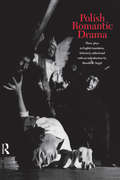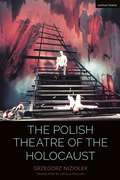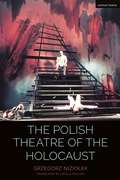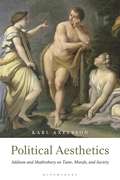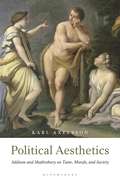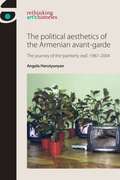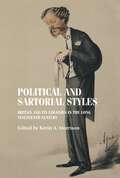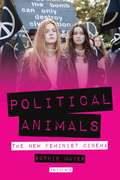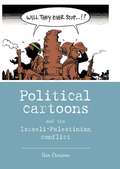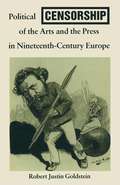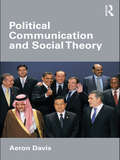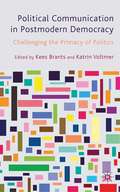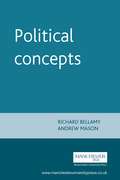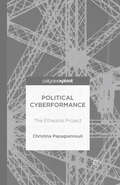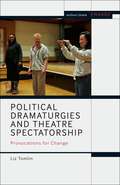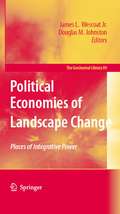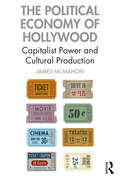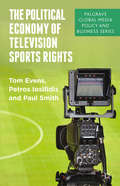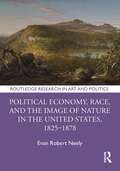- Table View
- List View
Polish Romantic Drama: Three Plays in English Translation
by Harold B. SegelThis is the first volume in English to be devoted entirely to Polish Romantic drama. It contains translations of three major plays: Forefathers; Eve, Part III, by Adam Mickiewics; The Un-Divine Comedy by Zygmunt Krasinski; and Fantazy by Juliusz Slowacki. In his highly informative introduction, Professor Segel discusses the plays against the background of the Romantic movement in Poland and points out their ideological and artistic importance. As products of a revolutionary Poland; they were written and published in Paris by writers who either resettled there after the Insurrection of 1830 or otherwise identified with the Great Emigration; they are permeated with the spirit of Romantic Rebellion, with pleas for universial justice, and with queries concerning the role of the poet in society. Brillant productions of the plays in Poland in the late nineteenth and early twentieth-centuries gave impetus to an entire tradition of modern Polish theatrical experimentation as well as dramatic writing which extends to the present day.
The Polish Theatre of the Holocaust (Cultural Histories of Theatre and Performance)
by Grzegorz NiziolekGrzegorz Niziolek's The Polish Theatre of the Holocaust is a pioneering analysis of the impact and legacy of the Holocaust on Polish theatre and society from 1945 to the present. It reveals the role of theatre as a crucial medium of collective memory – and collective forgetting – of the trauma of the Holocaust carried out by the Nazis on Polish soil. The period gave rise to two of the most radical and influential theatrical ideas during work on productions that addressed the subject of the Holocaust – Grotowski's Poor Theatre and Kantor's Theatre of Death - but the author examines a deeper impact in the role that theatre played in the processes of collective disavowal to being a witness to others' suffering. In the first part, the author examines six decades of Polish theatre shaped by the perspective of the Holocaust in which its presence is variously visible or displaced. Particular attention is paid to the various types of distortion and the effect of 'wrong seeing' enacted in the theatre, as well as the traces of affective reception: shock, heightened empathy, indifference. Inpart two, Niziolek examines a range theatrical events, including productions by Leon Schiller, Jerzy Grotowski, Tadeusz Kantor, Andrzej Wajda, Krzysztof Warlikowski and Ondrej Spišák. He considers how these productions confronted the experience of bearing witness and were profoundly shaped by the legacy of the Holocaust.The Polish Theatre of the Holocaust reveals how - by testifying about society's experience of the Holocaust - theatre has been the setting for fundamental processes taking place within Polish culture as it confronts suppressed traumatic wartime experiences and a collective identity shaped by the past.
The Polish Theatre of the Holocaust (Cultural Histories of Theatre and Performance)
by Grzegorz NiziolekGrzegorz Niziolek's The Polish Theatre of the Holocaust is a pioneering analysis of the impact and legacy of the Holocaust on Polish theatre and society from 1945 to the present. It reveals the role of theatre as a crucial medium of collective memory – and collective forgetting – of the trauma of the Holocaust carried out by the Nazis on Polish soil. The period gave rise to two of the most radical and influential theatrical ideas during work on productions that addressed the subject of the Holocaust – Grotowski's Poor Theatre and Kantor's Theatre of Death - but the author examines a deeper impact in the role that theatre played in the processes of collective disavowal to being a witness to others' suffering. In the first part, the author examines six decades of Polish theatre shaped by the perspective of the Holocaust in which its presence is variously visible or displaced. Particular attention is paid to the various types of distortion and the effect of 'wrong seeing' enacted in the theatre, as well as the traces of affective reception: shock, heightened empathy, indifference. Inpart two, Niziolek examines a range theatrical events, including productions by Leon Schiller, Jerzy Grotowski, Tadeusz Kantor, Andrzej Wajda, Krzysztof Warlikowski and Ondrej Spišák. He considers how these productions confronted the experience of bearing witness and were profoundly shaped by the legacy of the Holocaust.The Polish Theatre of the Holocaust reveals how - by testifying about society's experience of the Holocaust - theatre has been the setting for fundamental processes taking place within Polish culture as it confronts suppressed traumatic wartime experiences and a collective identity shaped by the past.
Political Aesthetics: Addison and Shaftesbury on Taste, Morals and Society
by Karl AxelssonProviding a gateway to a new history of modern aesthetics, this book challenges conventional views of how art's significance developed in society. The 18th century is often said to have involved a radical transformation in the concept of art: from the understanding that art is tool for some practical purpose, to the modern belief that it holds a distinctive and intrinsic value. By exploring the ground between these notions of art's function, Karl Axelsson reveals how scholars of culture made taste, morals, and a politically stable society an integral part of their claims about the experience of nature and art. Focusing on the writings advanced by two of the most prolific men of letters in the eighteenth century, Joseph Addison (1672–1719) and the third Earl of Shaftesbury (1671–1713) it contests the conviction that modern aesthetic autonomy was a reorientation in criticism and philosophy originally prompted by these two key figures in the history of aesthetics. By re-examining the political relevance of Addison's and Shaftesbury's theories of taste, Axelsson shows that they were, first and foremost, seeking to fortify a natural link between the aesthetic experience and the consolidation of modern political society.
Political Aesthetics: Addison and Shaftesbury on Taste, Morals and Society
by Karl AxelssonProviding a gateway to a new history of modern aesthetics, this book challenges conventional views of how art's significance developed in society. The 18th century is often said to have involved a radical transformation in the concept of art: from the understanding that art is tool for some practical purpose, to the modern belief that it holds a distinctive and intrinsic value. By exploring the ground between these notions of art's function, Karl Axelsson reveals how scholars of culture made taste, morals, and a politically stable society an integral part of their claims about the experience of nature and art. Focusing on the writings advanced by two of the most prolific men of letters in the eighteenth century, Joseph Addison (1672–1719) and the third Earl of Shaftesbury (1671–1713) it contests the conviction that modern aesthetic autonomy was a reorientation in criticism and philosophy originally prompted by these two key figures in the history of aesthetics. By re-examining the political relevance of Addison's and Shaftesbury's theories of taste, Axelsson shows that they were, first and foremost, seeking to fortify a natural link between the aesthetic experience and the consolidation of modern political society.
The political aesthetics of the Armenian avant-garde: The journey of the ‘painterly real', 1987–2004 (Rethinking Art's Histories)
by Angela HarutyunyanSheds light on artistic production and the emergence of contemporary art in Armenia from the ruins of the socialist utopian project and the failure to realise the romanticised consumerism of the capitalist West.
The political aesthetics of the Armenian avant-garde: The journey of the ‘painterly real', 1987–2004 (Rethinking Art's Histories)
by Angela HarutyunyanThis book addresses late-Soviet and post-Soviet art in Armenia in the context of turbulent transformations from the late 1980s to 2004. It explores the emergence of 'contemporary art' in Armenia from within and in opposition to the practices, aesthetics and institutions of Socialist Realism and National Modernism. This historical study outlines the politics (liberal democracy), aesthetics (autonomous art secured by the gesture of the individual artist), and ethics (ideals of absolute freedom and radical individualism) of contemporary art in Armenia and points towards its limitations. Through the historical investigation, a theory of post-Soviet art historiography is developed, one that is based on a dialectic of rupture and continuity in relation to the Soviet past. As the first English-language study on contemporary art in Armenia, the book is of prime interest for artists, scholars, curators and critics interested in post-Soviet art and culture and in global art historiography.
Political and sartorial styles: Britain and its colonies in the long nineteenth century (Studies in Design and Material Culture)
by Kevin MorrisonStarting with the premise that clothing is political and that analysing clothing can enhance understanding of political style, this collection explores the relationships among political theory, dress, and self-presentation during a period in which imperial and colonial empires assumed their modern form. Organised under three thematic clusters, the volume’s chapters range from an analysis of the uniforms worn by West India regiments stationed in the Caribbean to the smock frock donned by rural agricultural labourers, and from the self-presentations of members of parliament, political thinkers, and imperial administrators to the dress of characters and caricatures in novels, paintings, and political cartoon. With its interdisciplinary approach, the book will appeal to nineteenth-century cultural and social historians and literary critics as well as advanced undergraduate and postgraduate students whose research and teaching interests include gender, politics, material culture, and imperialism.
Political and sartorial styles: Britain and its colonies in the long nineteenth century (Studies in Design and Material Culture)
by Kevin A. MorrisonStarting with the premise that clothing is political and that analysing clothing can enhance understanding of political style, this collection explores the relationships among political theory, dress, and self-presentation during a period in which imperial and colonial empires assumed their modern form. Organised under three thematic clusters, the volume’s chapters range from an analysis of the uniforms worn by West India regiments stationed in the Caribbean to the smock frock donned by rural agricultural labourers, and from the self-presentations of members of parliament, political thinkers, and imperial administrators to the dress of characters and caricatures in novels, paintings, and political cartoon. With its interdisciplinary approach, the book will appeal to nineteenth-century cultural and social historians and literary critics as well as advanced undergraduate and postgraduate students whose research and teaching interests include gender, politics, material culture, and imperialism.
Political Animals: The New Feminist Cinema (International Library of the Moving Image (PDF))
by Sophie MayerFemale filmmakers are hitting the headlines. The last five years have witnessed: the first Best Director Academy Award won by a woman; women filmmakers emerging from Saudi Arabia, Brunei, Iran, South Korea, Japan, Paraguay, Uruguay, Burkina Faso and Kenya; the first stirrings of a 'trans cinema', with the release of films that represent transgender characters and their experiences, challenging our understanding of gender and identity; feminist porn screened at public festivals; and Pussy Riot's online documentation of offline activism sending shockwaves around the world. Political Animals argues that a new wave of feminist cinema is speaking to a new audience hungry for intersectional accounts of women in the public sphere that are missing in the mainstream. It reveals how innovative production and distribution strategies are responding to urgent political situations (resulting in colourful guerrilla aesthetics exemplified in the rough, D.I.Y, online videos made by Pussy Riot, but equally found in recent documentaries and features by established filmmakers too) and tunes in to the transnational, transgenerational conversations that are taking place between filmmakers such as Sally Potter, Claire Denis, Barbara Hammer, Mania Akbari, Haifaa al-Mansour, Emily Jacir, Andrea Arnold and Clio Barnard. Courageous and complex, the new feminist cinema is a political animal that, while laying claim to the public sphere as its own, refuses to be domesticated by it
Political cartoons and the Israeli-Palestinian conflict (New Approaches to Conflict Analysis)
by Ilan DanjouxDo political cartoon predict violence? To answer this question Ilan Danjoux examined over 1200 Israeli and Palestinian editorial cartoons to explore whether changes in their content anticipated the outbreak of the Al-Aqsa Intifada in October of 2000. Despite stark differences in political, economic and social pressures, a notable shift in focus, style and tone accompanied the violence. With numerous illustrations and detailed methodology, Political Cartoons and the Israeli Palestinian Conflict provides readers an engaging introduction to cartoon analysis and a novel insight into the Israeli-Palestinian conflict. In a region fraught with contested realities, the cartoon’s ability to capture the latent fears and unspoken beliefs of these antagonists offers a refreshing perspective on how both Israelis and Palestinians perceived each other and their chances for peace on the eve of the Second Intifada.
Political Censorship of the Arts and the Press in Nineteenth-Century
by Robert Justin GoldsteinPolitical Censorship of the Arts and the Press in Nineteenth-Century Europe presents a comprehensive account of the attempts by authorities throughout Europe to stifle the growth of political opposition during the nineteenth-century by censoring newspapers, books, caricatures, plays, operas and film. Appeals for democracy and social reform were especially suspect to the authorities, so in Russia cookbooks which refered to 'free air' in ovens were censored as subversive, while in England in 1829 the censor struck from a play the remark that 'honest men at court don't take up much room'. While nineteenth-century European political censorship blocked the open circulation of much opposition writing and art, it never succeeded entirely in its aim since writers, artists and 'consumers' often evaded the censors by clandestine circulation of forbidden material and by the widely practised skill of 'reading between the lines'.
Political Communication and Social Theory (Communication and Society)
by Aeron DavisPolitical Communication and Social Theory presents an advanced and challenging text for students and scholars of political communication and mass media in democracies. It draws together work from across political communication, media sociology and political sociology, and includes a mix of theoretical debate and current examples from several democratic media systems. Its wide ranging discussions both introduce and contest the traditional scholarship on a number of contemporary topics and issues. These include: comparative political and media systems theories of democracy, representation and the public sphere political party communication, marketing and elections the production of news media and public policy media sociology and journalist-source relations celebrity politics, popular culture and political leadership new media and online democracy national-global politics and international political communication foreign policy-making, war and media the crisis of public communication in established democracies. At the same time, Political Communication and Social Theory also offers a fascinating investigation of the causes of crisis in established political and media systems. In today’s democracies, trust in politicians, state institutions and mainstream media sources has dropped to new lows. The traditional business model that sustained journalism is failing and nations are struggling to respond to the existing global recession and impending environmental and resource crises. Drawing on interviews with over 100 experienced politicians, journalists and civil servants, Aeron Davis explores how the varied political actors and communicative processes, at the centre of UK democracy, may or may not be contributing to such crisis tendencies.
Political Communication and Social Theory (Communication and Society)
by Aeron DavisPolitical Communication and Social Theory presents an advanced and challenging text for students and scholars of political communication and mass media in democracies. It draws together work from across political communication, media sociology and political sociology, and includes a mix of theoretical debate and current examples from several democratic media systems. Its wide ranging discussions both introduce and contest the traditional scholarship on a number of contemporary topics and issues. These include: comparative political and media systems theories of democracy, representation and the public sphere political party communication, marketing and elections the production of news media and public policy media sociology and journalist-source relations celebrity politics, popular culture and political leadership new media and online democracy national-global politics and international political communication foreign policy-making, war and media the crisis of public communication in established democracies. At the same time, Political Communication and Social Theory also offers a fascinating investigation of the causes of crisis in established political and media systems. In today’s democracies, trust in politicians, state institutions and mainstream media sources has dropped to new lows. The traditional business model that sustained journalism is failing and nations are struggling to respond to the existing global recession and impending environmental and resource crises. Drawing on interviews with over 100 experienced politicians, journalists and civil servants, Aeron Davis explores how the varied political actors and communicative processes, at the centre of UK democracy, may or may not be contributing to such crisis tendencies.
Political Communication in Postmodern Democracy: Challenging the Primacy of Politics
by Kees Brants and Katrin VoltmerThis edited collection examines the changing faces of political communication in contemporary democracy. Based on comparative investigations of recent trends in the Netherlands and Great Britain, the essays provide fresh insights and new empirical evidence into the public representation of media-centred politics.
Political concepts
by Richard Bellamy Andrew MasonOffers a sophisticated analysis of central political concepts in the light of recent debates in political theory. Introduces students to some of the main interpretations of key political conceps highlighting their strengths and weaknesses. Tackles the principle concepts employed to justify any policy or institution and examines the main domestic purposes and functions of the state. Examines the relationship between state and civil society and finally looks beyond the state to issues of global concern and inter-state relations. Studies the relationship between state and civil society and finally looks beyond the state to issues of global concern and inter-state relations.
Political Cyberformance: The Etheatre Project
by Christina PapagiannouliWritten from a practice-based perspective, this book focuses on the political character of 'cyberformance': the genre of digital performance that uses the Internet as a performance space. The Etheatre Project comprises a series of experimental cyberformances aiming to reconsider the characteristics of theatre in the Internet age.
Political Dramaturgies and Theatre Spectatorship: Provocations for Change (Methuen Drama Engage)
by Liz TomlinWhat do we mean when we describe theatre as political today? How might theatre-makers' provocations for change need to be differently designed when addressing the precarious spectator-subject of twenty- first century neoliberalism? In this important study Liz Tomlin interrogates the influential theories of Jacques Rancière to propose a new framework of analysis through which contemporary political dramaturgies can be investigated. Drawing, in particular, on Ernesto Laclau and Chantal Mouffe, Lilie Chouliaraki and Judith Butler, Tomlin argues that the capacities of the contemporary and future spectator to be 'effected' or 'affected' by politically-engaged theatre need to be urgently re-evaluated.Central to this study is Tomlin's theorized figuration of the neoliberal spectator-subject as precarious, individualized and ironic, with a reduced capacity for empathy, agency and the ability to imagine better futures. This, in turn, leads to a predilection for a response to injustice that is driven by a concern for the feelings of the subject-self, rather than concern for the suffering other. These characteristics are argued to shape even those spectator-subjects towards the left of the political spectrum, thus necessitating a careful reconsideration of new and long-standing dramaturgies of political provocation.Dramaturgies examined include the ironic invitations of Made in China and Martin Crimp, the exploration of affect in Kieran Hurley's Heads Up, the new sincerity that characterizes the work of Andy Smith, the turn to the staging of the spectators' 'other' in Developing Artists' Queens of Syria and Chris Thorpe and Rachel Chavkin's Confirmation, and the community activism of Common Wealth's The Deal Versus the People.
Political Dramaturgies and Theatre Spectatorship: Provocations for Change (Methuen Drama Engage)
by Liz TomlinWhat do we mean when we describe theatre as political today? How might theatre-makers' provocations for change need to be differently designed when addressing the precarious spectator-subject of twenty- first century neoliberalism? In this important study Liz Tomlin interrogates the influential theories of Jacques Rancière to propose a new framework of analysis through which contemporary political dramaturgies can be investigated. Drawing, in particular, on Ernesto Laclau and Chantal Mouffe, Lilie Chouliaraki and Judith Butler, Tomlin argues that the capacities of the contemporary and future spectator to be 'effected' or 'affected' by politically-engaged theatre need to be urgently re-evaluated.Central to this study is Tomlin's theorized figuration of the neoliberal spectator-subject as precarious, individualized and ironic, with a reduced capacity for empathy, agency and the ability to imagine better futures. This, in turn, leads to a predilection for a response to injustice that is driven by a concern for the feelings of the subject-self, rather than concern for the suffering other. These characteristics are argued to shape even those spectator-subjects towards the left of the political spectrum, thus necessitating a careful reconsideration of new and long-standing dramaturgies of political provocation.Dramaturgies examined include the ironic invitations of Made in China and Martin Crimp, the exploration of affect in Kieran Hurley's Heads Up, the new sincerity that characterizes the work of Andy Smith, the turn to the staging of the spectators' 'other' in Developing Artists' Queens of Syria and Chris Thorpe and Rachel Chavkin's Confirmation, and the community activism of Common Wealth's The Deal Versus the People.
Political Economies of Landscape Change: Places of Integrative Power (GeoJournal Library #89)
by Douglas M. Johnston James L. Jr WescoatThis hugely important and timely work asks how politics and economics transform the landscapes we inhabit. It explores the connections between political economy and landscape change through a series of conceptual essays and case studies. In so doing, it speaks to a broad readership of landscape architects, geographers, and related fields of social and environmental research.
The Political Economy of Hollywood: Capitalist Power and Cultural Production
by James McMahonIn Hollywood, the goals of art and business are entangled. Directors, writers, actors, and idealistic producers aspire to make the best films possible. These aspirations often interact with the dominant firms that control Hollywood film distribution. This control of distribution is crucial as it enables the firms and other large businesses involved, such as banks that offer financing, to effectively stand between film production and the market. This book analyses the power structure of the Hollywood film business and its general modes of behaviour. More specifically, the work analyses how the largest Hollywood firms attempt to control social creativity such that they can mitigate the financial risks inherent in the art of filmmaking. Controlling the ways people make or watch films, the book argues, is a key element of Hollywood’s capitalist power. Capitalist power—the ability to control, modify, and, sometimes, limit social creation through the rights of ownership—is the foundation of capital accumulation. For the Hollywood film business, capitalist power is about the ability of business concerns to set the terms that will shape the future of cinema. For the major film distributors of Hollywood, these terms include the types of films that will be distributed, the number of films that will be distributed, and the cinematic alternatives that will be made available to the individual moviegoer. Combining theoretical analysis with detailed empirical research on the financial performance of the major Hollywood film companies, the book details how Hollywood’s capitalist goals have clashed with the aesthetic potentials of cinema and ultimately stymied creativity in the pursuit of limiting risk. This sharp critique of the Hollywood machine provides vital reading for students and scholars of political economy, political theory, film studies, and cinema.
The Political Economy of Hollywood: Capitalist Power and Cultural Production
by James McMahonIn Hollywood, the goals of art and business are entangled. Directors, writers, actors, and idealistic producers aspire to make the best films possible. These aspirations often interact with the dominant firms that control Hollywood film distribution. This control of distribution is crucial as it enables the firms and other large businesses involved, such as banks that offer financing, to effectively stand between film production and the market. This book analyses the power structure of the Hollywood film business and its general modes of behaviour. More specifically, the work analyses how the largest Hollywood firms attempt to control social creativity such that they can mitigate the financial risks inherent in the art of filmmaking. Controlling the ways people make or watch films, the book argues, is a key element of Hollywood’s capitalist power. Capitalist power—the ability to control, modify, and, sometimes, limit social creation through the rights of ownership—is the foundation of capital accumulation. For the Hollywood film business, capitalist power is about the ability of business concerns to set the terms that will shape the future of cinema. For the major film distributors of Hollywood, these terms include the types of films that will be distributed, the number of films that will be distributed, and the cinematic alternatives that will be made available to the individual moviegoer. Combining theoretical analysis with detailed empirical research on the financial performance of the major Hollywood film companies, the book details how Hollywood’s capitalist goals have clashed with the aesthetic potentials of cinema and ultimately stymied creativity in the pursuit of limiting risk. This sharp critique of the Hollywood machine provides vital reading for students and scholars of political economy, political theory, film studies, and cinema.
The Political Economy of Television Sports Rights (Palgrave Global Media Policy and Business)
by T. Evens P. Iosifidis P. SmithSport on television is big business, but it is about more than just commerce. Using a range of national case studies from Europe and beyond, this book analyses the political, economic, social and regulatory issues raised in relation to the buying and selling of television sports rights.
Political Economy, Race, and the Image of Nature in the United States, 1825–1878 (Routledge Research in Art and Politics)
by Evan Robert NeelyPolitical Economy, Race, and the Image of Nature in the United States, 1825–1878 is an interdisciplinary work analyzing the historical origins of a dominant concept of Nature in the culture of the United States during the period of its expansion across the continent.Chapters analyze the ways in which “Nature” became a discursive site where theories of race and belonging, adaptation and environment, and the uses of literary and pictorial representation were being renegotiated, forming the basis for an ideal of the human and the nonhuman world that is still with us. Through an interdisciplinary approach involving the fields of visual culture, political economy, histories of racial identity, and ecocritical studies, the book examines the work of seminal figures in a variety of literary and artistic disciplines and puts the visual culture of the United States at the center of intellectual trends that have enormous implications for contemporary cultural practice.The book will be of interest to scholars working in art history, visual culture, American studies, environmental studies/ecocriticism, critical race theory, and semiotics.
Political Economy, Race, and the Image of Nature in the United States, 1825–1878 (Routledge Research in Art and Politics)
by Evan Robert NeelyPolitical Economy, Race, and the Image of Nature in the United States, 1825–1878 is an interdisciplinary work analyzing the historical origins of a dominant concept of Nature in the culture of the United States during the period of its expansion across the continent.Chapters analyze the ways in which “Nature” became a discursive site where theories of race and belonging, adaptation and environment, and the uses of literary and pictorial representation were being renegotiated, forming the basis for an ideal of the human and the nonhuman world that is still with us. Through an interdisciplinary approach involving the fields of visual culture, political economy, histories of racial identity, and ecocritical studies, the book examines the work of seminal figures in a variety of literary and artistic disciplines and puts the visual culture of the United States at the center of intellectual trends that have enormous implications for contemporary cultural practice.The book will be of interest to scholars working in art history, visual culture, American studies, environmental studies/ecocriticism, critical race theory, and semiotics.
